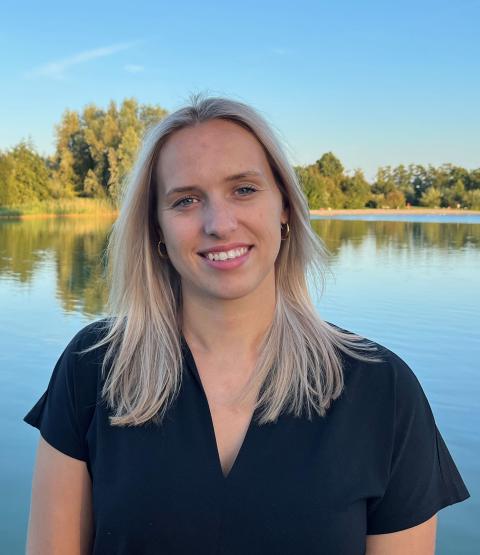PhD research on the digital transformation of military organizations: ‘Ordinary soldiers are a driving force’
PhD candidate Mylène Struijk spent the last four years at a multinational military base, documenting and analyzing the organization’s digital transformation. Her research reveals that digital innovation is not so much driven by decision-makers at the highest levels, but rather by ordinary soldiers who increasingly tend to experiment with the possibilities of the internet, apps and other digital technologies. The organization faces a dilemma: how do you create enough room for experimentation and innovation on the work floor without losing grip? “A new balance must be forged.”
Imagine that your colleague is in a life-threatening situation and it's your responsibility to arrange an emergency medical evacuation. Do you follow the existing protocols for a safe exchange of information, even though those protocols might be time-consuming and in need of modernization, or do you pop out your phone and quickly share the relevant information via WhatsApp?
“For military personnel, considerations like these are very real,” Mylène Struijk says. The information systems they work with are often outdated, while every soldier with a smartphone has the newest and fastest technologies within hand's reach. “Military organizations have been digitizing for years, but it's a slow and difficult process. For many staff members, change doesn't come quickly enough. What we see is that they take it upon themselves to start experimenting with digital technologies.”

I was expecting to find a very streamlined top-down approach to digital innovation, with generals rolling out the strategy from higher up and personnel carrying out the predetermined plans. But it unfolds organically, with ordinary soldiers as the driving force behind digitalization.
No structured strategy
Struijk conducted a large part of her research at the headquarters of a multinational military organization comprising various European air forces. When she started her research in 2019 and became familiar with the organization, the way the digital transformation unfolded surprised her. “I was expecting to find a very streamlined top-down approach, with generals rolling out the strategy from higher up and personnel carrying out the predetermined plans,” she explains. “But when you start to look more closely, you see that the process takes a very different form in practice. It unfolds organically, with ordinary soldiers as the driving force behind digitalization.”
This week, Struijk will defend her PhD thesis “IT Governance in the Digital Era: Insights from Meta-Organizations" at Tilburg University. She argues that the rise of consumer-oriented technologies – such as social media, apps and cloud services – has caused a shift in the way digital transformations unfold. In the era of consumer technology, innovation starts on the work floor rather than in boardrooms.
Experimenting employees
Military organizations are no exception. Experimenting employees accelerate the digital transformation, Struijk says. That's a positive development, because digitalization is necessary and urgent. But at the same time, unauthorized experiments can bring serious security risks and may cause tension between layers of the organization where innovation takes a different pace.
“In general, managers are a lot more hesitant to use new technology. Workers want autonomy and modernization. Management wants to maintain control, for instance over which technologies are used,” Struijk says.
The reluctance of military management to experiment with new tech can be explained. Military organizations don't have the agility of a startup, Struijk says, and there is a lot at stake. “Not every technology is safe to use. And you need to keep in mind that most military organizations have been around for a very long time and are used to operating in a certain way. If a 100-year-old organization has always used telephones for the exchange of information when carrying out missions, it's a big step to suddenly start using a new technology that has only just entered the market.”
Balance between autonomy and control
Still, Struijk says it's important for organizations to create room for innovation on the work floor, and that good ideas are upscaled and implemented. “That's happening more and more. For example, taskforces are created that include people from all organizational levels, from high generals to lower-ranked soldiers, who collaboratively roll out initiatives that originated on the work floor.”
In her dissertation, Struijk calls for a new balance. Between autonomy and control, and between the freedom to innovate and the responsibility to use technologies safely. “At the moment, what we see is that the cultural transformation on the work floor is taking place at a higher pace than the structural transformation of the organization. Those processes should be brought more in balance.”
Innovative research
Mylène Struijk's doctoral research is innovative. Her findings shake up current thinking in the academic field of IT governance. “We have to step away from the idea that digital transformations take place according to deliberate strategies,” she says. “In the current literature, the central question is how company-oriented IT is being implemented by managers. I think we have to shift our focus and think about the impact of consumer technology, and how its use by ordinary workers shapes digital transformations.”
Note for the press
Mylène Struijk is a PhD candidate at the Tilburg School of Economics and Management (TiSEM). She defends her dissertation on 29 September at 10.00 CET in the Auditorium of Tilburg University. A livestream will be available. Thesis title: IT Governance in the Digital Era: Insights from Meta-Organizations. Supervisors: prof. C. Ou and dr. S. Angelopoulos.
For more information, please contact Mylène Struijk directly (m.struijk@tilburguniversity.edu), or get in touch with TiSEM's science communicator Laura van Gelder (l.f.vangelder@tilburguniversity.edu).
